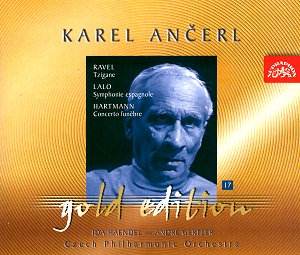Under the inspired
conducting of Karel Ančerl (1908-1973), the Czech Philharmonic
Orchestra reached the pinnacle of the finest of international
orchestras. Ančerl’s many Supraphon recordings with the orchestra
gained world-wide praise and won many prestigious awards.
This album is listed number seventeen in that label’s ‘Gold Edition’
reissues in excellent 24-bit digitally remastered sound. Every
one of Ida Haendel’s breathlessly stated little notes in Ravel’s
dazzling virtuoso showpiece, Tzigane, is, as we used to
say, ‘as sharp as a gnat’s kneecap.’
Haendel’s dark sultry gypsy-like appearance seemed
so suitable for this brilliant Ravel show-stopper. Here she delivers
a fiery and ravishing virtuoso performance surmounting all the
work’s prodigious technical demands,
its many swift shifts of mood, rhythm and tempi. There is passion
here but also a deep affecting melancholy. Ančerl’s accompaniment
is nicely balanced with Haendel’s violin; it sparkles and has
plenty of attack and atmosphere.
Ida Haendel (b. 1928), British by Polish descent,
was awarded the CBE in 1991 for her exceptional contribution to
music. She made numerous recordings for Supraphon including the
beautifully expressive and technically immaculate reading of Lalo’s
tuneful Symphonie espagnole, colourfully based on Spanish
dance forms. It is also included on this album. Her shaping of
the first movement’s big tune is movingly heartfelt and her reading
of the exuberant Rondo is sheer vivacity. Evident throughout is
Ančerl’s meticulous care for
orchestral clarity and detail as well as his dramatic emotional
involvement. Example after example of his pliant and colourful
readings come to mind, notably the opening pages of the Scherzando
and the intensity of the lovely Andante and the colour
and verve of his Rondo.
In passing it is worth noting that another classic
Czech Philharmonic recording of the Symphonie espagnole
is available on Virgin Classics VC5 45022-2. This 1992-93 version
is conducted by Libor Pešek, with Christian Tetzlaff. It is coupled
with Dvořák’s Violin Concerto.
Karl Amadeus Hartmann’s Concerto funèbre
was conceived during the first days of World War II. The shock
and woe of those times, that must have been particularly painfully
felt by Czech listeners, is starkly expressed in the ultra-brief
1˝ minute opening movement that quotes an early Bohemian chorale.
Hungarian violinist, André Gertler eloquently expresses
the desolation and anguish in the elegiac Adagio second movement.
before awakening from passive melancholy to bristling defiance
and attack in the Allegro di molto att. third movement.
The concerto’s beautiful and affecting finale is in tragic chorale-style
mood, a lament citing a Russian revolutionary dirge, Immortal
Sacrifice.
Splendid performances of the popular Ravel and
Lalo works, and a heartfelt reading of Hartmann’s vision of the
tragedy that was WWII, make this a confident recommendation.
Ian Lace
